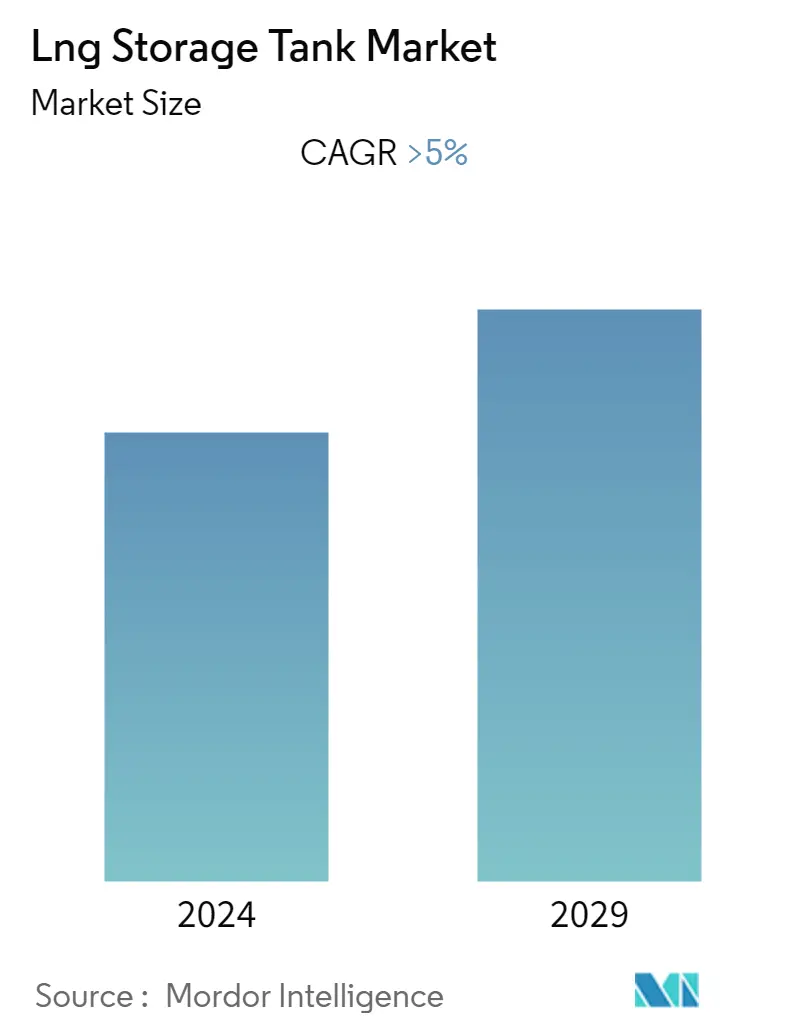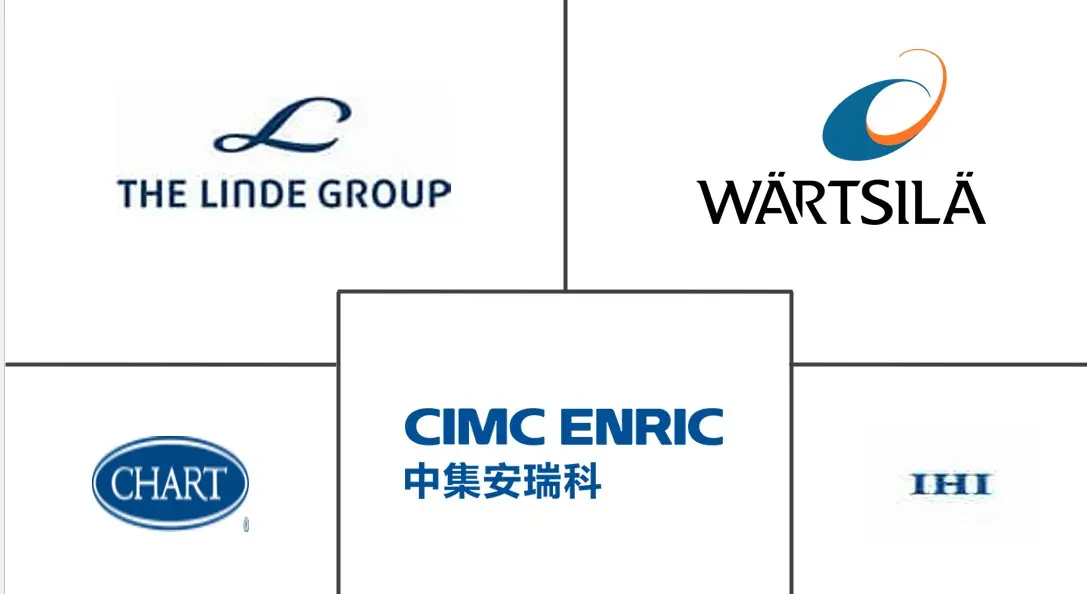Market Size of Lng Storage Tank Industry

| Study Period | 2020 - 2029 |
| Base Year For Estimation | 2023 |
| CAGR | 5.00 % |
| Fastest Growing Market | Asia-Pacific |
| Largest Market | Asia-Pacific |
| Market Concentration | Medium |
Major Players
*Disclaimer: Major Players sorted in no particular order |
LNG Storage Tank Market Analysis
The LNG Storage Tank Market is estimated to grow at a CAGR of greater than 5% during the forecast period.
The COVID-19 pandemic led to a pause in production at end users in the LNG storage tank industry because of the global lockdown. This has hampered the growth of the market in the year 2020 and is likely to continue through 2022. The pandemic COVID-19 has also affected the sales of LNG storage tanks since the second quarter of 2020 because of the steep decline in demand for LNG and is anticipated to cause a negative impact on the market growth in the first half of 2022.
Developing and emerging countries like India, China, Japan, and South Korea are witnessing a high demand for LNG storage tanks. The growth in the APAC region can be attributed to significant developments in power, energy, and technologies plus the growing trade of LNG, which is expected to drive the LNG storage tank market in the region. Moreover, APAC being the largest producer of steel and availability of raw materials, for instance, iron ore, and cost-effective labor will also drive the demand during the forecast period.
The global liquefied natural gas (LNG) tanker fleet encompassed a total of 700 vessels at the end of 2021. Between 2010 and 2021, figures steadily increased. With LNG trade volumes reaching 488 billion cubic meters in 2020, greater number of tankers are paramount to satisfying growing consumer demand. LNG tankers vary in sizes, with the largest being able to carry up to 266,000 cubic meters.
Japan had the world's largest liquefied natural gas (LNG) storage tank capacity in 2021, at 18.2 million cubic meters. This was followed by neighboring South Korea and China, with a tank capacity of 12.4 million and 11.3 million cubic meters, respectively. All three countries also had the largest LNG regasification capacity.
LNG Storage Tank Industry Segmentation
A liquefied natural gas storage tank or LNG storage tank is a specialized type of storage tank used for the storage of Liquefied Natural Gas. LNG storage tanks can be found on the ground, above ground, or in LNG carriers. LNG storage tanks have double containers, where the inner contains LNG and the outer container contains insulation materials. The LNG Storage Tank Market is segmented By Product Type (Self-supporting and Non-Self-supporting Tanks), By Material Type (Steel, 9% Nickel Steel, Aluminum Alloys, and Others), and By Geography ( (North America, Europe, Asia-Pacific, Latin America, Middle East, and Africa). The report offers market size and forecasts for LNG Storage Tank Market in value ( USD Billion ) for all the above segments.
| By Product Type | |
| Self-Supporting Tanks | |
| Non-Self Supporting Tanks |
| By Material Type | |
| Steel | |
| 9% Nickel Steel | |
| Aluminium Alloys | |
| Other |
| Geography | ||||||||||
| ||||||||||
| ||||||||||
| ||||||||||
| ||||||||||
|
Lng Storage Tank Market Size Summary
The LNG storage tank market is poised for significant growth, driven by increasing global demand for liquefied natural gas across various sectors such as power, energy, and steel industries. The market experienced a temporary setback due to the COVID-19 pandemic, which disrupted production and led to a decline in LNG demand. However, the market is expected to recover and expand, particularly in developing regions like Asia-Pacific, where countries such as India, China, Japan, and South Korea are witnessing a surge in demand. This growth is supported by advancements in power and energy technologies, as well as the region's status as a major steel producer with abundant raw materials and cost-effective labor. The global LNG trade is also on the rise, with increasing vessel numbers and capacity, further fueling the demand for storage tanks.
The market landscape is characterized by a mix of local and international players, including major companies like Linde Plc, Wärtsilä, and CIMC Enric, who are actively engaging in strategies such as product launches, acquisitions, and collaborations to enhance their market presence. The expansion of LNG infrastructure and the shift towards LNG as a marine fuel alternative are contributing to the market's growth trajectory. Additionally, the U.S. remains a key player in natural gas production, with significant volumes transported via sea routes to meet international demand. The market's future growth is anticipated to be driven by the increasing use of LNG in various industrial applications, the rise in small-scale LNG trade, and the ongoing efforts to meet Net Zero Emissions targets.
Lng Storage Tank Market Size - Table of Contents
-
1. MARKET DYNAMICS
-
1.1 Market Overview
-
1.2 Market Drivers
-
1.3 Market Restraints
-
1.4 Value Chain / Supply Chain Analysis
-
1.5 Porters 5 Force Analysis
-
1.5.1 Threat of New Entrants
-
1.5.2 Bargaining Power of Buyers/Consumers
-
1.5.3 Bargaining Power of Suppliers
-
1.5.4 Threat of Substitute Products
-
1.5.5 Intensity of Competitive Rivalry
-
-
1.6 PESTLE Analysis
-
1.7 Technological Advancements in the Market
-
1.8 Impact of Covid -19 on the Market
-
-
2. MARKET SEGMENTATION
-
2.1 By Product Type
-
2.1.1 Self-Supporting Tanks
-
2.1.2 Non-Self Supporting Tanks
-
-
2.2 By Material Type
-
2.2.1 Steel
-
2.2.2 9% Nickel Steel
-
2.2.3 Aluminium Alloys
-
2.2.4 Other
-
-
2.3 Geography
-
2.3.1 North America
-
2.3.1.1 US
-
2.3.1.2 Canada
-
2.3.1.3 Mexico
-
-
2.3.2 Europe
-
2.3.2.1 Germany
-
2.3.2.2 UK
-
2.3.2.3 France
-
2.3.2.4 Russia
-
2.3.2.5 Spain
-
2.3.2.6 Rest of Europe
-
-
2.3.3 Asia Pacific
-
2.3.3.1 India
-
2.3.3.2 China
-
2.3.3.3 Japan
-
2.3.3.4 Singapore
-
2.3.3.5 Malaysia
-
2.3.3.6 South Korea
-
2.3.3.7 Australia
-
2.3.3.8 Rest of Asia Pacific
-
-
2.3.4 South America
-
2.3.4.1 Brazil
-
2.3.4.2 Argentina
-
2.3.4.3 Rest of South America
-
-
2.3.5 Middle East & South Africa
-
2.3.5.1 UAE
-
2.3.5.2 Saudi Arabia
-
2.3.5.3 South Africa
-
2.3.5.4 Rest of Middle East & South Africa
-
-
-
Lng Storage Tank Market Size FAQs
What is the current Lng Storage Tank Market size?
The Lng Storage Tank Market is projected to register a CAGR of greater than 5% during the forecast period (2024-2029)
Who are the key players in Lng Storage Tank Market?
Linde Plc, Wärtsilä, Cimc Enric, Chart Industries and IHI Corporation are the major companies operating in the Lng Storage Tank Market.

